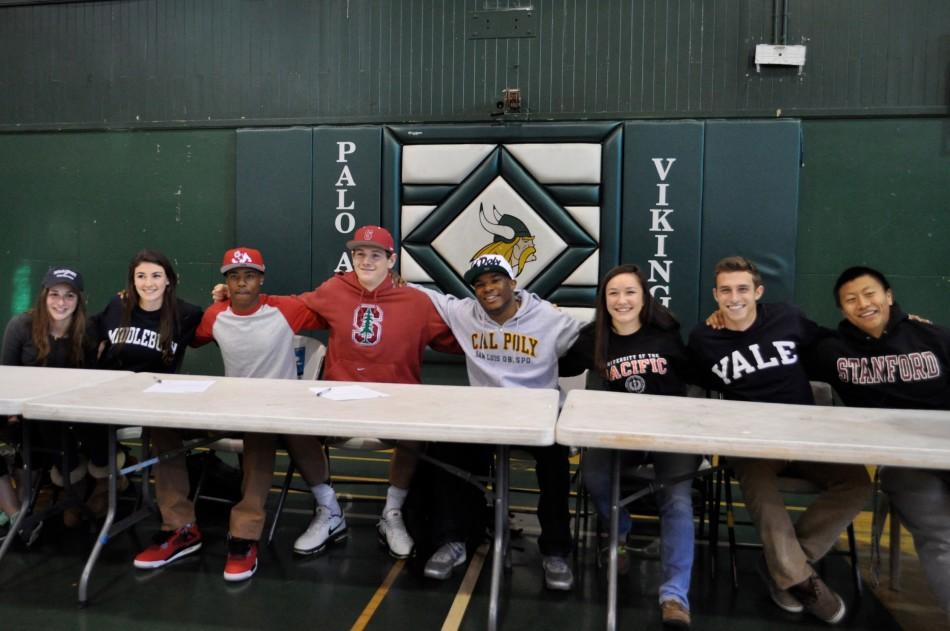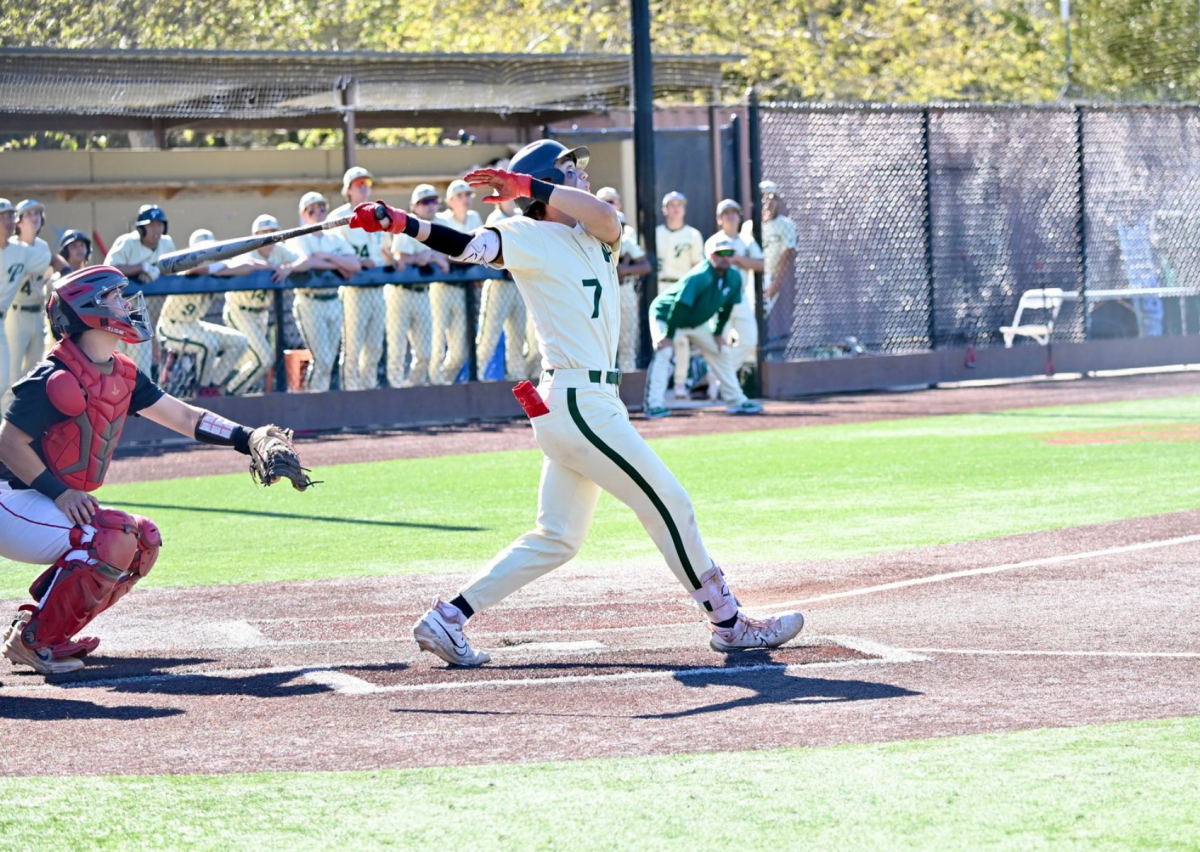Early bird gets the word
On February 5th, eight seniors signed the National Letter of Intent after commiting early to play their sport at various schools.
April 16, 2014
Each year, aspiring Division I athletes clamor to earn a place on the teams of elite, big-name universities. In turn, these universities seek out only the best athletes to fill their rosters in hopes of maintaining their prestigious reputations in athletics. In recent years, significant changes have occurred within the recruiting process as colleges recruit increasingly younger athletes.
In February, Palo Alto High School’s Jacey Pederson (‘16) committed to play soccer at UCLA. Not even half way through her high school career, Pederson already has a clear collegiate path.
Pederson updated this news via Instagram post, sharing “Beyond stoked to be committed to UCLA! Such a blessing to be able to represent such an awesome school #bruwinning”. Many of Pederson’s followers were amazed to hear of her commitment, including one peer who commented on the photo, “Wuuuut that’s crazy congrats!”. So, was Pederson’s commitment truly crazy?
Since Pederson began playing soccer in the first grade, she has excelled greatly. She has been a key player on Paly’s varsity soccer team for the past two years and was named the Female Underclassmen of the Year for her outstanding athletic ability by The Viking in 2013. Additionally, she has been a devoted member on her club team PSV Union and has played for the U.S. National Team.
Despite her notable successes as a player, Pederson’s commitment is actually not an exceptional case. According to the National College Scouting Association, 24% of girl soccer players commit early to colleges, a figure second only to girls’ lacrosse where 36% of players commit early. An early commitment occurs before a student can sign the National Letter of Intent (during their senior year), when a coach offers a scholarship for a student to play at their school and the student verbally accepts this offer. Verbal commitments are non-binding for both the schools and the students, meaning that the school may decide to withdraw their offer and the student may also choose to play for a different school.
According to Robin Lent from College Counseling Associates in Menlo Park, a college counselor who works specifically with athletes who hope to play at a collegiate level, verbal commitments still hold significant meaning in the realm of college sports.
“Even though [verbal commitment] is non-binding, the collegiate sports world is relatively small with the idea that once you make a verbal commitment on the athletes and the coaches side that it is an ethically binding agreement” Lent said, “It rarely happens when some other offer comes along and upsets that verbal commitment” Lent adds.
This year, eight Paly seniors signed their National Letters of Intent on February 5th to officially play for colleges across the country, all of whom had committed early—although none did so as early as Pederson who will sign her letter of intent in 2016.
While Pederson’s commitment was recent, she became involved in the recruiting process much earlier, when she was still in middle school.
“I began talking to coaches during eighth grade,” Pederson said, “I’d previously gone to some college showcases like in seventh grade I went to one in Las Vegas”.
The N.C.A.A. has set in place various regulations meant to prevent colleges from recruiting younger athletes, yet Pederson admits that there are loopholes in the system. All of the rules are structured around high school students and prohibit certain types of contacts with coaches and students during their sophomore, junior, and senior years. However, there are no explicit restrictions regarding students in middle school communicating with coaches.
“Since I was a middle schooler it was perfectly fine for me to talk to coaches and for them to call me back and stuff so in that sense it was really beneficial that I could like get to know the coaches”.
Roughly ten years ago, it would have been unheard of for an athlete to be identified by a college in middle school, however this is now relatively common occurrence.
“The one significant thing I think has changed over the last five to eight to nine years is that recruiting is starting much much earlier”. Lent said, “When I first started [counseling] kids, I would get students in January of their Junior year and then we’d start the process—now, that’s too late”.
Recruiting has turned into a race where the college that is recruiting the youngest athletes is in the lead. These schools want to fill their rosters with the best athletes and get strong recruiting classes, which translates to the pursuit of increasingly younger students. There is an ‘early bird gets the worm’ mentality in recruiting—or in this case, early bird gets the word, the verbal commitment of an athlete.
“There are certain periods of time where the coach is not allowed to talk to the athlete, so they need to know way in advance who is coming, who isn’t and who is going to commit” Lent said.
“I think that committing isn’t necessarily a huge benefit for the players other than getting that sense of relief and having a goal, something to work towards” Pederson shared. “But I think it’s more of a benefit towards the coaches ‘cause they get their recruiting classes ready, they have an idea of what type of positions they have coming in, or what type of players they’ll have in the future so they don’t needa recruit those type of players”
Early commitment is essential in the recruiting process, however it can put immense pressures on the students.
“If a student wants to play that sport at that level, then they need to make that kind of decision as a freshman—they want to put themselves in a place where they can get exposure” Lent said.
Deciding where to attend college can be a stressful and difficult process for any student, but perhaps is even more so for students who need to make this instrumental decision at such a young age.
“The whole process was pretty overwhelming, just the fact I had to decide where I wanted to go to college yet it’s two and a half years away was pretty mind blowing” said Pederson.
It is certain that the recruiting process has evolved in recent years as younger athletes are making early commitments. Committing to a school as an underclassmen is becoming more of a norm—so perhaps Pederson’s commitment isn’t so ‘crazy’ after all.






